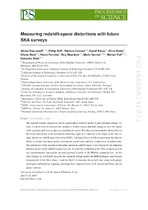Measuring redshift-space distortion with future SKA surveys

View/
Date
2014Author
Raccanelli, Alvise
Bull, Philip
Camera, Stefano
Bacon, David
Blake, Chris
Dore, Olivier
Ferreira, Pedro G.
Maartens, Roy
Santos, Mario G.
Viel, Matteo
Zhao, Gong-Bo
Metadata
Show full item recordAbstract
The peculiar motion of galaxies can be a particularly sensitive probe of gravitational collapse. As
such, it can be used to measure the dynamics of dark matter and dark energy as well the nature
of the gravitational laws at play on cosmological scales. Peculiar motions manifest themselves as
an overall anisotropy in the measured clustering signal as a function of the angle to the line-ofsight,
known as redshift-space distortion (RSD). Limiting factors in this measurement include our
ability to model non-linear galaxy motions on small scales and the complexities of galaxy bias.
The anisotropy in the measured clustering pattern in redshift-space is also driven by the unknown
distance factors at the redshift in question, the Alcock-Paczynski distortion. This weakens growth
rate measurements, but permits an extra geometric probe of the Hubble expansion rate. In this
short chapter we will briefly describe the scientific background to the RSD technique, and forecast
the potential of the SKA phase 1 and the SKA2 to measure the growth rate using both galaxy
catalogues and intensity mapping, assessing their competitiveness with current and future optical
galaxy surveys.
